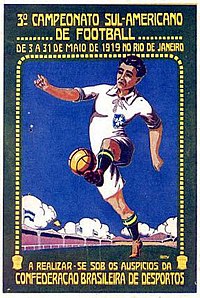The 1919 South American Championship of Nations was the third continental championship for South American national football teams. It was held in Rio de Janeiro, Brazil from 11 to 29 May 1919.
 Poster | |
| Tournament details | |
|---|---|
| Host country | Brazil |
| Dates | 11–29 May |
| Teams | 4 (from 1 confederation) |
| Venue(s) | 1 (in 1 host city) |
| Final positions | |
| Champions | |
| Runners-up | |
| Third place | |
| Fourth place | |
| Tournament statistics | |
| Matches played | 7 |
| Goals scored | 27 (3.86 per match) |
| Top scorer(s) | (4 goals each) |

The participating countries were Brazil, Argentina, Chile and Uruguay as the defending champion.
After finishing tied in the group standings on points, host Brazil beat Uruguay in the playoff match to win their first title.
The playoff was the longest match in the competition's history, and under current rules, will remain so indefinitely: with the score tied 0-0 after 90 minutes had expired, both captains and the referee agreed to play an extra time period of two 15-minute halves. When 120 minutes expired with the score still tied 0-0, both captains and the referee agreed to play a second extra time period of two 15-minute halves; thus, the playoff match lasted 150 minutes.[1]
Format
editThere was no qualifying for the tournament. The participating countries were Argentina, Brazil, Chile and Uruguay. All teams competed between each other in a single group. Two points were awarded for a win, one for a draw and zero for a defeat. If there was a tie of points at the top of the standings, a playoff match would be held to determine the champion.
Squads
editFor a complete list of participating squads see: 1919 South American Championship squads
Venues
edit| Rio de Janeiro |
|---|
| Estádio das Laranjeiras |
| Capacity: 20,000 |
Final round
editEach team played one match against each of the other teams. Two points were awarded for a win, one point for a draw and zero points for a defeat.
| Team | Pld | W | D | L | GF | GA | GD | Pts |
|---|---|---|---|---|---|---|---|---|
| Brazil | 3 | 2 | 1 | 0 | 11 | 3 | +8 | 5 |
| Uruguay | 3 | 2 | 1 | 0 | 7 | 4 | +3 | 5 |
| Argentina | 3 | 1 | 0 | 2 | 7 | 7 | 0 | 2 |
| Chile | 3 | 0 | 0 | 3 | 1 | 12 | −11 | 0 |
| Brazil | 6–0 | Chile |
|---|---|---|
| Friedenreich 19', 38', 76' Neco 21', 83' Haroldo 79' |
| Argentina | 2–3 | Uruguay |
|---|---|---|
| Izaguirre 34' Varela 79' (o.g.) |
C. Scarone 19' H. Scarone 23' Gradín 85' |
| Uruguay | 2–0 | Chile |
|---|---|---|
| C. Scarone 31' J. Pérez 43' |
| Argentina | 4–1 | Chile |
|---|---|---|
| Clarcke 10', 23', 62' Izaguirre 13' |
France 33' |
Play-off
edit| Brazil | 1–0 (a.e.t.) | Uruguay |
|---|---|---|
| Friedenreich 122' |
Result
edit| 1919 South American Championship champions |
|---|
| Brazil First title |
Goal scorers
edit4 goals
3 goals
- Edwin Clarcke
- Carlos Izaguirre
- Carlos Scarone
2 goals
1 goal
Own goals
- Manuel Varela (for Argentina)
Aftermath
editThe day after the final, Uruguayan goalkeeper Roberto Chery died in hospital in Rio de Janeiro of a strangulated hernia; he had been injured after attempting to stop a goal during the match against Chile. As substitutions were not allowed at the time, Chery had to play the rest of the match while severely injured.[3]
Brazil and Uruguay had scheduled a friendly match ("Copa Rio Branco") for 19 June 1919, but following Chery's tragic death, the Uruguayan team declined to play. Argentina offered to replace the Uruguayan side, which the Brazilian Federation accepted, and the match was played as the "Copa Roberto Chery" to honor the late Uruguayan goalkeeper. Argentina entered the field wearing Uruguay's traditional light-blue jersey, while Brazil wore the jersey of Uruguayan club Peñarol.[4]
References
edit- ^ La subyugante historia de la Copa América
- ^ Oliver, Guy (1992). The Guinness Record of World Soccer. Guinness publishing. p. 551. ISBN 0-85112-954-4.
- ^ Una historia trágica en la Copa América on Prensa Libre, 13 June 2016
- ^ La más hermosa página de fraternidad, El Gráfico